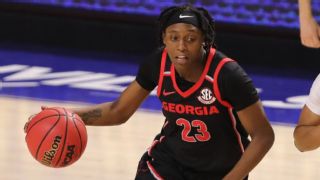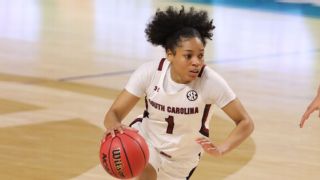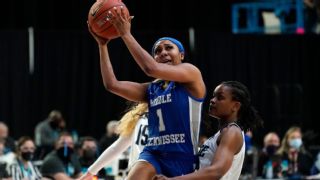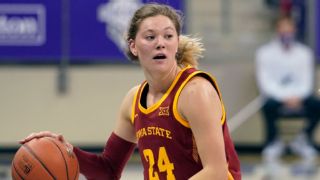|
The NCAA opted to name the four regions in the 2021 women's basketball tournament after famous sites in San Antonio, where a champion will be crowned at the Alamodome on April 4. When you think of San Antonio, which was previously host to the Women's Final Four in 2002 and 2010, you envision the Alamo, the River Walk, the Hemisfair and the Mercado. The region names are a reminder of the beauty of the city, and one team will make a perfect 6-0 memory there and leave with the NCAA title. Will it be No. 1 overall seed Stanford, seeking the program's long-awaited third national championship? Will UConn raise the trophy for a 12th time? Could NC State get its first title? Or will South Carolina claim its second? Those are the No. 1 seeds, but are they the favorites from each corner of the bracket to reach the Final Four? We look at each regional, including five players to watch who aren't necessarily the known stars, but could be important keys to their team's hopes of staying in San Antonio until April. Navigate to each region: Alamo | Hemisfair | River Walk | Mercado
Alamo RegionalThree weeks in the NCAA's controlled environment in San Antonio should be easier for Stanford than any other team in the field. The overall No. 1 seed spent nine weeks on the road from December to February this season because of enhanced COVID-19 guidelines that prohibited all contact sports in Santa Clara County, California. Along the way, Stanford's Tara VanDerveer became the all-time winningest coach in Division I women's basketball. The Cardinal have an incredible mix of veteran leadership and a ton of talent. Second-seeded Louisville also had its ups and downs with COVID-19, including a three-week pause and a handful of missed games. The Cardinals still emerged as the ACC regular-season champion, with Dana Evans, one of the country's best players, leading Louisville through it all. Still, Georgia might be the best story in the region. Led by four seniors all working on their master's degrees, the Lady Dogs went from being picked to finish ninth in the SEC to a No. 3 seed in the NCAA tournament. Five players to watch Que Morrison, Georgia: The fiery leader of those Georgia seniors, Morrison is averaging 11.8 points and 5.2 rebounds per game. More importantly, she and fellow senior Gabby Connally developed a knack for big plays in big moments. Morrison also shared the SEC defensive player of the year award with South Carolina's Aliyah Boston. Hailey Van Lith, Louisville: Van Lith didn't have the year that freshman stars Paige Bueckers or Caitlin Clark have had, but she has had a solid first season and could be on the cusp of a breakout moment. Evans remains the No. 1 option, but Van Lith averaged 11.2 points and 5.5 rebounds, the latter stat pretty amazing for a 5-foot-7 guard. If the Cardinals are to make a fourth Final Four under coach Jeff Walz, Van Lith's lefty shooting stroke might be a key. Amber Ramirez, Arkansas: A bit lost in the shadows of more well-known teammates Chelsea Dungee and Destiny Slocum, Ramirez is the Razorbacks' best 3-point and free throw shooter. Ramirez, who knocks down 44 percent of her 3-pointers, might be the lightning rod for Arkansas' success. Late in the season she had 35 points in an easy win over Alabama. Six days later the Razorbacks lost to Ole Miss when Ramirez shot 4-of-18 from the field.  Cierra Hall, UC Davis: The Big West defensive player of the year as a junior, Hall upgraded this season to league player of the year. She is extremely versatile, but her perimeter scoring is the X factor. Because the Aggies only played 15 games and endured a seven-week pause, Hall only attempted 53 3-pointers. She made 47.2 percent. Veronica Burton, Northwestern: A two-time Big Ten defensive player of the year, Burton graduated to top Wildcats' scorer this season by going into attack mode. Her 159 trips to the free throw line, where she shoots 80 percent, led the Big Ten. The defensive end is still her calling card, though. Burton led the country in steals at over four per game.  Team that could ruin your bracket: Missouri State. The fifth-seeded Lady Bears haven't lost since the week before Christmas and completely dominated the Missouri Valley Conference. Brice Calip, Jasmine Franklin and Abby Hipp are talented and experienced enough to scare any bigger-name program. Missouri State took down Maryland earlier this season, knocked off 23rd-ranked Minnesota two years ago upset DePaul and Iowa State on their way to the Sweet 16 in the 2019 NCAA tournament. If Missouri State makes it that far again, Stanford, the team that ended the Lady Bears' run two years ago, could be waiting. Matchup we'd like to see: Stanford vs. Arkansas. If the Lady Bears don't get in the way, the Cardinal and fourth-seeded Razorbacks would make for a compelling Sweet 16 matchup. Arkansas' style of play is focused on three components: Take plenty of 3-pointers, make layups, and get to the free throw line. That gives the Razorbacks a chance against any team (see: this season's wins over Baylor and UConn). The strategy VanDerveer employs to slow down Dungee and how Mike Neighbors of Arkansas combats the size, depth and smarts of the Cardinal is the game within a game that would make this one so intriguing. Which teams advance? Stanford, Missouri State, Georgia and Louisville are my picks to reach the Sweet 16. Stanford advances to the Final Four. -- Creme
Hemisfair Regional A year ago South Carolina looked ready to win a national championship. The Gamecocks would have been the No. 1 overall seed entering the 2020 tournament, with Oregon, Baylor and Maryland also strong contenders before the coronavirus pandemic canceled the event. Disappointment ran high in Columbia, South Carolina. Dawn Staley and the Gamecocks, Hemisfair's No. 1 seed, are once again one of the favorites to win the 2021 title. But it's a packed region, beginning with No. 2 seed Maryland. The Terps are scoring nearly five more points per game than anyone else in the country and have an All-America point guard in sophomore Ashley Owusu. With South Carolina's Aliyah Boston, UCLA's Michaela Onyenwere, Texas' Charli Collier, Georgia Tech's Lorela Cubaj and West Virginia's Esmery Martinez, the region also features some of this season's best frontcourt players. Boston and Cubaj were their conference's defensive players of the year. Collier is expected to be the No. 1 pick in the WNBA draft, where Onyenwere is also a likely top-10 pick. Martinez averages a double-double. Five players to watch Aleah Goodman, Oregon State: If one player is responsible for the Beavers turning around their season, it's Goodman. After Oregon State's four-week COVID-19 pause, her steady hand guided the Beavers to an 8-2 record after Jan. 24 (both losses were against No. 1 overall seed Stanford). The 5-9 senior played over 35 minutes per game and led the Beavers in points, assists and free throw percentage, and shot nearly 50% from 3-point range. Charisma Osborne, UCLA: Onyenwere gets most of the attention in Westwood, but Osborne is right behind her in importance to the Bruins. The sophomore point guard is averaging 17 points and nearly four assists per game. Osborne's 24 points paved the way to UCLA's biggest win of the season, a four-point win over Stanford. Lotta-Maj Lahtinen, Georgia Tech: The ACC's most improved player, Lahtinen went from 9.1 points per game last season to 14.6 in 2020-21, and has been a big part of the Yellow Jackets' turnaround under coach Nell Fortner. Not flashy, but she's a grinder whose work is easy to admire. Kysre Gondrezick, West Virginia: Fearless, enthusiastic and productive, Gondrezick put together the kind of senior season that is typically award-worthy. Her 19.9 points, 4.5 assists and 37.4 minutes per game led the Mountaineers, and she did it playing through the pain of her father's death in January. Angel Reese, Maryland: We didn't see much of Reese, the No. 2-rated recruit in the class of 2020, during the regular season. A broken foot limited her to just 12 games, but she has still managed to average 10 points and more than six rebounds per game. Now she serves as a talented extra piece to an already dynamic offense.  Team that could ruin your bracket: Alabama. The Crimson Tide might just be happy to get out of the SEC, where they played some of the best teams close, but couldn't quite get over the hump against South Carolina, Texas A&M and Georgia. Now they get a fresh start. With a coach (Kristy Curry) who has been to the NCAA tournament before, potent offense and three seniors (Jordan Lewis, Jasmine Walker, and Ariyah Copeland) looking to make one last run together, Alabama might have the ingredients to whip up an upset or two. Matchup we'd like to see: Maryland vs. South Carolina. There's no matchup in this region that would rival this would-be epic Elite Eight meeting. The nation's highest scoring offense against one of its best and most physical defenses, this would resemble a national championship-caliber game two rounds early. Both coaches would prefer a high pace, which means 94 feet of non-stop action. To add to the intrigue, Maryland starts two transfers -- Mimi Collins and Chloe Bibby -- who began their careers playing against South Carolina in the SEC. Which teams advance? South Carolina, Maryland, UCLA and West Virginia are my picks to reach the Sweet 16. South Carolina advances to the Final Four. -- Creme
River Walk RegionalWe said on Selection Monday that this looked like the toughest of the four regionals, and a lot of that has to do with the top two seeds in this corner of the bracket. Top-seeded UConn and 2-seed Baylor were supposed to meet Jan. 7, but their matchup was canceled because the Lady Bears were on a COVID-19 pause. They could face off in the Elite Eight (their series is tied 4-4), and that matchup would feature two first-team All-Americans in UConn's Paige Bueckers and Baylor's NaLyssa Smith. Both teams will face plenty of challenges before then, and COVID-19 has already impacted UConn, as head coach Geno Auriemma and assistant Shea Ralph are away from the team. Auriemma tested positive on Sunday, while Ralph had a family member test positive on Wednesday. If seeds hold, there are two intriguing second-round games: No. 4 Kentucky vs. No. 5 Iowa, and No. 3 Tennessee vs. No. 6 Michigan. The Wildcats lost three of their last five games, but still have SEC player of the year Rhyne Howard (20.7 PPG, 7.3 RPG), and victories this season over fellow NCAA tournament teams like Indiana, Arkansas, Alabama, Tennessee and Georgia. Iowa, led by another freshman phenom in Caitlin Clark, the Division I scoring leader (26.7 PPG), made a run to the Big Ten tournament final. Tennessee-Michigan could showcase Big Ten player of the year Naz Hillmon (25.1 PPG, 11.4 RPG) vs. Lady Vols senior standout Rennia Davis (17.2 PPG, 8.8 RPG). Five players to watch Anastasia Hayes, Middle Tennessee: The junior guard was near the top of Division I in scoring all season, and at 26.5 PPG currently sits second behind Clark. No. 14 seed Middle Tennessee is making its 19th NCAA tournament appearance and first since 2016.  Monika Czinano, Iowa: The junior forward/center is leading Division I women in field goal percentage at 67.8 (230 of 339) and has averaged 19.5 points and 5.9 rebounds this season. She averaged 26.8 points in the Big Ten tournament. Elizabeth Kitley, Virginia Tech: The sophomore center was first-team All-ACC and averaged a double-double (18.5 PPG, 10.7 RPG). She has helped lead the seventh-seeded Hokies to their first NCAA tournament appearance since 2006. Leigha Brown, Michigan: Her teammate, Hillmon, has had a fabulous season, but Brown played a big role, too. The junior guard/forward is averaging 16.9 PPG, 4.4 RPG and 3.2 APG. Kamilla Cardoso, Syracuse: The 6-7 center was the media's pick for ACC freshman of the year, averaging 13.7 PPG, 8.3 RPG and 2.6 BPG.  Team that could ruin your bracket: Florida Gulf Coast. The No. 11 seed is 26-2 overall and on a 25-game winning streak, led by Atlantic Sun player of the year Kierstan Bell (24.3 PPG, 10.8 RPG). The Eagles were 16-0 in ASUN conference play, and then won the conference tournament. This is FGCU's seventh tournament appearance, and the Eagles are still looking for their first Sweet 16. They would have to get past Michigan and then probably Tennessee to get there this year. Matchup we'd like to see: Baylor vs. Tennessee. The first thing everyone noticed is the potential for the Bueckers-Clark showdown if UConn and Iowa make the Sweet 16. But let's look at the bottom part of the bracket. A Baylor-Tennessee regional semifinal would be interesting. The Lady Bears lead the series 6-2, with three meetings in the NCAA tournament. The most recent of those was in the 2012 Elite Eight, the last game on the sideline for late Lady Vols coach Pat Summitt. Baylor won the NCAA title that year and went 40-0. Which teams advance? UConn, Baylor, Tennessee and Iowa are my picks to reach the Sweet 16. Baylor advances to the Final Four. -- Voepel
Mercado Regional It's the 10th anniversary of Texas A&M's national championship, and this year the Aggies won the SEC regular-season title. A loss to Georgia in the SEC semifinals likely cost them a No. 1 seed, which might give second-seeded Texas A&M a rougher road to the Elite Eight than top-seeded NC State. The Wolfpack repeated as ACC tournament champions after winning last year for the first time since 1991. Their NCAA tournament No. 1 seed is the first in program history, and there isn't a big obstacle on their path to the regional final if they play well. The region's first-round matchup between No. 8 seed South Florida and No. 9 seed Washington State features two of the most multinational teams in the field. The Bulls have 11 players from eight countries outside the United States, and the Cougars have nine players from seven nations other than the U.S.. Both teams made history this season: South Florida won its first American Athletic Conference tournament crown, and Washington State is making the program's first NCAA appearance since 1991. No. 3 seed Arizona hasn't been absent from the field that long. But Wildcats and Pac-12 player of the year Aari McDonald are making the program's first NCAA appearance since 2005. Five players to watch Ashley Joens, Iowa State: The junior wing has been one of the Big 12's star players the past two years, averaging 23.6 PPG and 9.2 rebounds this season. She always carries a heavy load for the Cyclones. Kayla Jones, NC State: Junior center Elissa Cunane (16.8 PPG, 8.2 RPG) is the driving force for NC State, but others have filled roles well around her. Including Jones, a senior forward who is third on the team in scoring (12.3 PPG) and second in rebounding (7.3 RPG). Diamond Johnson, Rutgers: The freshman guard is second on the team in scoring (17.9 PPG) to senior Arella Guirantes (20.8 PPG) and leads the Scarlet Knights in 3-pointers (49) while shooting 45 percent from long range. Mackenzie Holmes, Indiana: The sophomore forward leads the Hoosiers in scoring (18.1 PPG), rebounding (7.8 RPG) and blocked shots (65). She was on the Big Ten's first team and the all-defensive team. Charlisse Leger-Walker, Washington State: The guard from New Zealand joined her older sister, redshirt senior Krystal, on the Cougars and became a Pac-12 sensation, earning league freshman of the year honors at 18.9 PPG.  Team that could ruin your bracket: Rutgers. The No. 6 seed didn't look like itself, especially defensively, in a 73-62 Big Ten quarterfinal loss to Iowa. But the Scarlet Knights won nine games in a row before that. If Rutgers recaptures that mojo, it could be dangerous. Matchup we'd like to see: NC State vs. Texas A&M. If chalk holds -- and it seems probable -- we'll get a matchup between the Wolfpack's center-dominant team vs. the Aggies' guard-led squad. This wouldn't be a game of huge star matchups, but that won't make it any less intriguing. Texas A&M's depth is in the perimeter, but forward N'dea Jones is averaging a double-double (12.3 PPG, 10.3 RPG). And while Cunane is the Wolfpack's primary focus, their guards' defense could be the deciding factor. Which teams advance? NC State, Texas A&M, Indiana and Rutgers are my picks to reach the Sweet 16. NC State advances to the Final Four. -- Voepel
|

